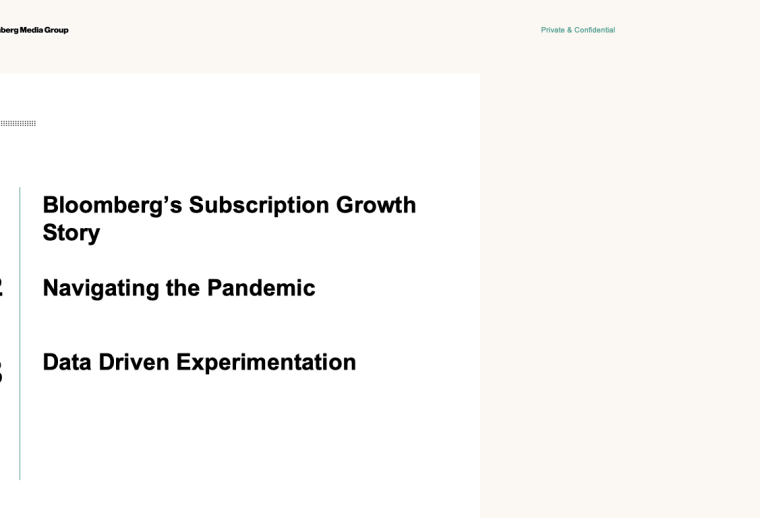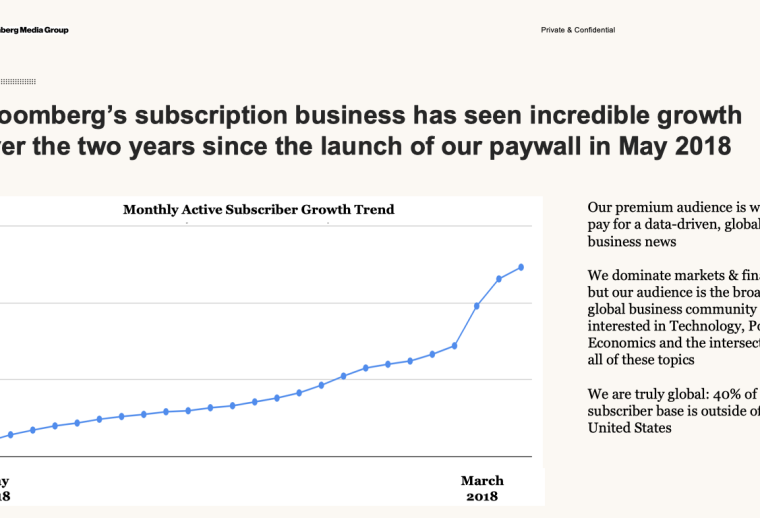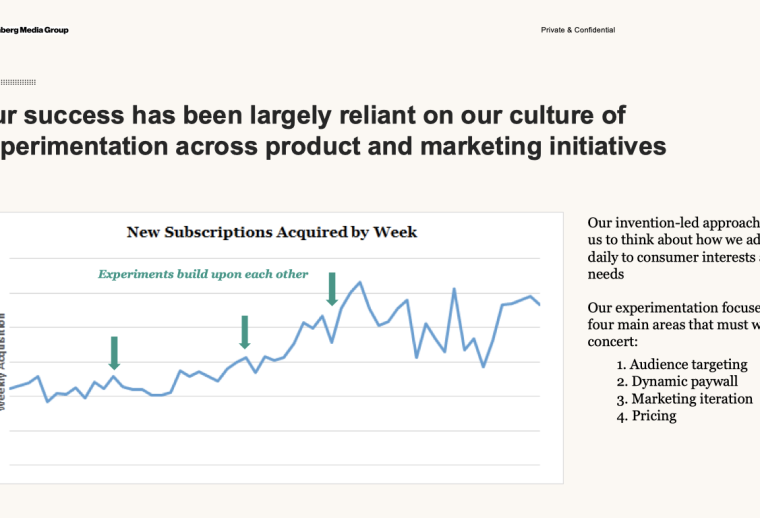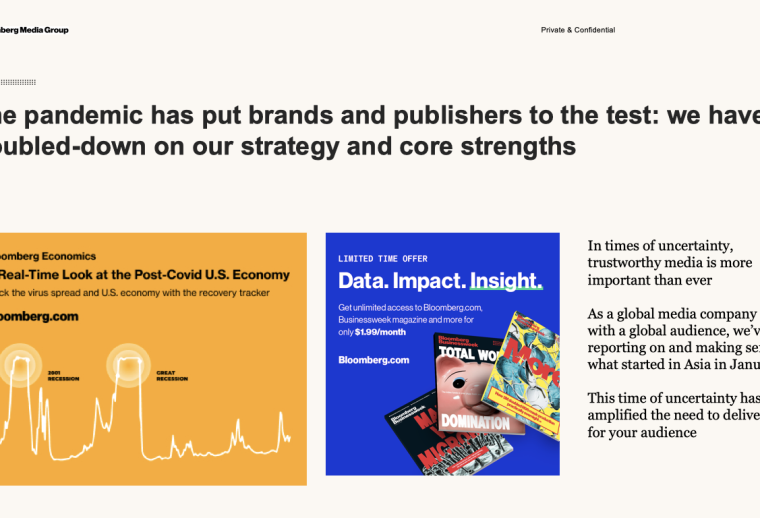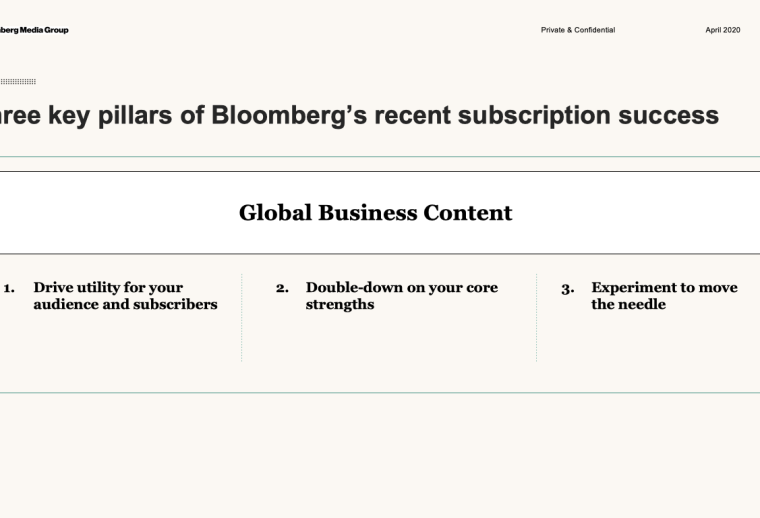
Subscriptions are essential, now more than ever for publishers. For many, thanks to the coronavirus, there’s also been a corresponding corona-bump in subs as readers flock to sites for news.
But gaining subscribers is only part of the story. The other one is churn. One factor that subscription publishers have to be wary of is going too low with introductory offers, especially when the subscription product is at a premium price. “The lower you go, the higher your churn is going to be so striking that balance is really important as well as having a lot of options,” said Lindsay Horrigan, global head of subscriptions & consumer marketing of Bloomberg Media.
In order to ensure that not only the number of subscribers was increasing but subscription revenue increased as well, Horrigan said experimentation was key.
The big question, especially for subscribers that have flooded in due to the coronavirus, is whether they will stick around beyond the pandemic.
“If it is indeed a different cohort, you have to look at what it was that got them to convert — then keep doing it. Most important thing is to deliver on what that expectation was from those people that converted,” she said.
In the latest edition of the Digiday+ Talks, where speakers focus on instructive and actionable content, Horrigan talked about experimenting for customer retention beyond the coronavirus, tips for messaging and marketing, and using propensity models to prioritize engagement.
Digiday+ members can access slides and full video of the Talk below.
Managing churn
The pandemic led to increases in page views —Bloomberg had 120 million unique visitors across its digital network in March — as well as a boost in the number of active subscribers. Though the rate of new subscribers acquired during the pandemic has come down since its peak, Horrigan said that the company has achieved a sustained growth in new acquisitions that still remains about four times what its previous daily average was in terms of new subscribers.
“We are also seeing sustained churn and some cohorts are looking like they are performing better than some of our benchmarks as well,” she said.
- “The question is, are these fly by night? I don’t think so, at least for us,” said Horrigan. “It just may be that the critical nature of the coronavirus got them off the sidelines a little bit faster but they weren’t necessarily new people that hadn’t had any exposure to us before.”
- The subscribers that were acquired during the pandemic, Horrigan said, have been more likely to do a monthly or three-month subscription.
- From a retention standpoint, Horrigan said these subscribers are behaving similarly to how typical subscribers behave when they’re first coming on board. The monthly option, for instance, is rather typical of people because “most people want to get used to it before you lock into something long term,” she said.
Being experimental is key
Horrigan said that this week when she checked in with her team, she learned that there were 30 experiments running concurrently across the site to try and improve the subscription business. Some of them, she said, are a win, while others are not successful, but across the board, the experiments build off of each other and allow her team to be nimble in how they strategize to reduce churn and increase acquisition.
She shared two recent experiments tied to acquisition and retention that yielded positive results:
- The first test manipulated the messaging on the yellow paywall banner. Version A of the banner used the basic marketing messaging with the term length and pricing. Version B included that same messaging, but added topical and contextual language related to the article page that the reader was on. For example, an article about markets would have a line saying “Stay on top of historical market volatility with Bloomberg’s global coverage.”
- The second test focused on retention and targeted a cohort of subscribers that were identified as being more likely to churn once their subscriptions were done. Proactively, Horrigan said her team began offering a longer term subscription to those readers at a reduced rate that would lock them versus allowing them to churn after their few-month-long subscription was over.
- The first test yielded a 5% increase in revenue on the banners that included topical messaging. The second test reduced the churn of that cohort by 10%, but it also drove revenue up by 74% because those readers were moving into a more expensive and longer term subscription offering.
Using a propensity model for acquisition and retention
There are 30 attributes that Bloomberg Media measures when trying to understand its audience and their propensity to become and stay subscribers, Horrigan said. This enables her team to have an individualized experience for each of the readers who are interacting with the brand.
- Some readers may be more price-conscious, while others are likelier to be focused on the content. Bloomberg uses technology that tracks these behaviors and allows readers to have a very individualized experience when considering whether or not to become a subscriber, making it more likely that they will be persuaded.
- “The cool part of machine learning and algorithms is that you can’t parse it apart. It’s taking those 30 attributes and determining what is the best experience for that person,” said Horrigan.
- She said, however, that one recurring theme regardless of the individual is that engagement is of the utmost importance. “If you haven’t been engaging with us recently, your likelihood to subscribe is going to be lower and your likelihood to churn is going to be higher.”

